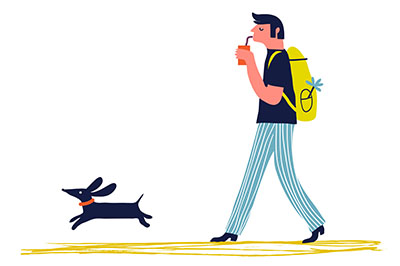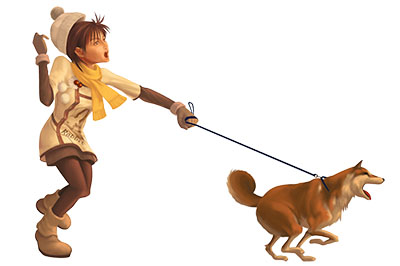Last updated January 2020
A pack of apps—Wag!, Rover, PetBacker, and others—offer to link gig-economy workers with pet owners, aiming to turn leashing up Fido for his midday potty break into an on-demand service like getting a car ride (Lyft) or having ramen delivered to your house (Uber Eats). These companies make sign-up and coordination very easy: Just register via the app or online and provide your credit card info, and for about $20 per half hour one of their walkers will take Spot or Muffin out while you’re at work or otherwise engaged.
The concept seems like a great innovation—until you read the horror stories. When you hire a dog walker, you’d expect them to not only take your pooch for a spin around the park, but also to keep him or her alive and well. But several dogs—a Wheaten terrier named Winnie in Houston, a Seattle mutt named Bandit—have been killed while on Wag! walks. And according to a lawsuit filed in Los Angeles, Snoopy the papillon died after wandering out of the yard of a Rover contract worker (who is also a former Baywatch actress).
 The marketing pitches on these companies’ websites on safety are designed to make you feel as comfortable as a yellow lab napping in the sun. Much like Thumbtack or TaskRabbit, they promise to carry insurance to reimburse you for damage to your property by employees plus cover the costs of some veterinary care, in case your pooch is injured while on a walk.
The marketing pitches on these companies’ websites on safety are designed to make you feel as comfortable as a yellow lab napping in the sun. Much like Thumbtack or TaskRabbit, they promise to carry insurance to reimburse you for damage to your property by employees plus cover the costs of some veterinary care, in case your pooch is injured while on a walk.
These financial guarantees are reassuring, but most pet owners would rather these companies carefully select and screen their workers—and we’re not sure they do. Wag!, Rover, and PetBacker all say they conduct background checks and vet their walkers, but provide few details on what they actually do. “I’m not a dog lover, but I can’t imagine the randomness of using these services,” says Edgar Dworsky, a consumer lawyer and the force behind ConsumerWorld.org, a noncommercial website devoted to consumer issues. “You don’t quite know who you’re going to get, and it’s not like you can use a resource like the Better Business Bureau to check out these individuals.”
We checked on the application process for these companies, and it seemed pretty easy to get a gig walking pooches with them. Yes, potential walkers must correctly answer some questions on pet safety and have their references contacted. And while this may screen out possible dognappers or complete idiots (think Scooby Doo in human form), we think it does little to ascertain whether wannabe employees have any experience or expertise with animals—or if they will be careful with your furry family members.
So how do you hire help? One resource is the (limited) customer reviews available at Checkbook.org. (Please help out other members by posting reviews of walkers you’ve tried.) Also ask other pet parents or your vet for recommendations.
In general, we recommend going with an individual you find on your own or with a service that employs walkers, as opposed to using the apps. Says Marny Nofi, an animal behavior expert at the American Society for the Prevention of Cruelty to Animals (ASPCA), “Many caregivers identify themselves as ‘pet lovers.’ There is a large difference between someone who has owned pets and someone who works professionally with animals. If you have a pet who is well socialized and can adapt to change easily, this might not be an issue. However, if your dog or cat has any underlying behavioral issues, then having a ‘pet lover’ versus an experienced pet handler may result in some unexpected issues.”
But don’t entirely rule out these apps, either. “Using an app to initially locate a care provider can be a great way to expand your support system,” Nofi says. “But it would be in your pet’s best interests to narrow the field to one or two consistent caregivers.”
 No matter whom you consider, do the following:
No matter whom you consider, do the following:
- Ask to see documentation that the service currently carries liability insurance.
- Check references from other pet owners—not the walker’s friends or mom.
- Ask how the team or individual will deal with your pet. In addition to getting your contact information and other basic facts, some services compile detailed profiles of your fur darling and his or her habits (“High-energy puppy that needs a daily run”; “Elderly terrier that’s bushed after a short walk”). You could even create your own doggie dossier and update it as your pet’s needs change.
- Whether you are using an individual or a larger service, have the specific walker over to see if he or she gets along with Scruffy, and whether he or she asks detailed questions and seems attentive to your pet.
- Ask for pricing. Rates can range from $10–$30 per walk, depending on time spent and what company or person you use. Ask if booking regular walks can net you a discounted rate.
- Find out how the walker will get into your home to pick up your pup. Some of the apps recommend getting a lockbox; with a company or individual you use repeatedly, you’ll likely give them a key. It’s easier to feel secure doing this if the person comes from an established company or is someone you use regularly.
- Ask pointed questions: How long will you spend walking my dog? What will you do to make sure he or she doesn’t eat something bad, get off-leash, or tangle with other critters? What’s your training and experience?
- Find out what happens if the walker gets sick or can’t show up because of an emergency.
- Ask if the walker will take your pet to your veterinarian if he or she gets sick or injured.
- Find out what special services the walker or walking company offers. Most will refill the dog’s water bowl, some will send phone pics of your mutt or Malamute romping in the park. Most offer a “key hold” arrangement where they have a copy of your house key so that they can get in if you have to burn the midnight oil at work or need them for some other reason.


